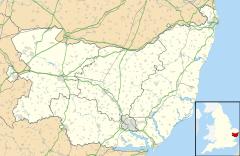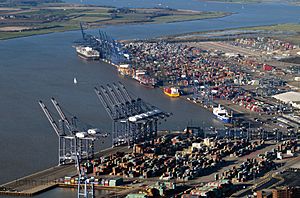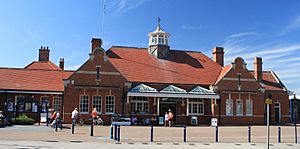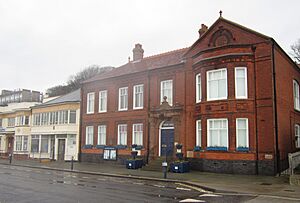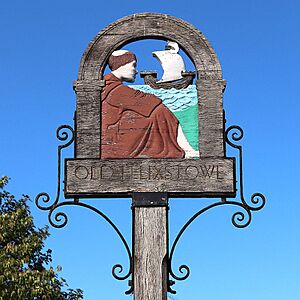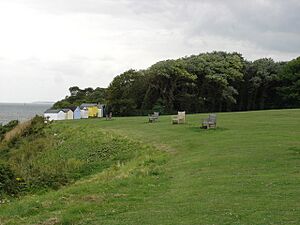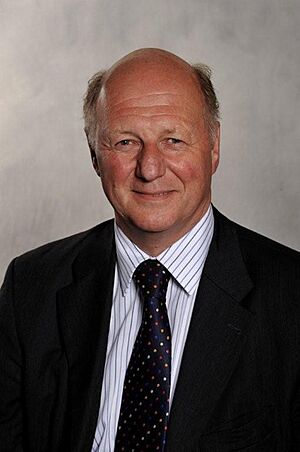Felixstowe facts for kids
Quick facts for kids Felixstowe |
|
|---|---|
| Town and civil parish | |
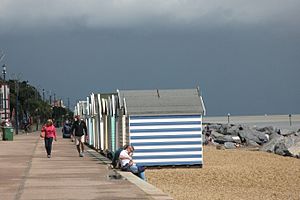 Felixstowe beach |
|
| Population | 24,521 (East Suffolk estimate, 2017) |
| OS grid reference | TM306345 |
| Civil parish |
|
| District |
|
| Shire county | |
| Region | |
| Country | England |
| Sovereign state | United Kingdom |
| Post town | Felixstowe |
| Postcode district | IP11 |
| Dialling code | 01394 |
| Police | Suffolk |
| Fire | Suffolk |
| Ambulance | East of England |
| EU Parliament | East of England |
| UK Parliament |
|
Felixstowe is a port town and civil parish in the East Suffolk area of Suffolk, England. In 2017, about 24,521 people lived there. The Port of Felixstowe is the biggest container port in the United Kingdom. Felixstowe is about 72 miles (116 km) northeast of London.
Contents
- History of Felixstowe
- Transport in Felixstowe
- How Felixstowe is Governed
- Landmarks and Attractions
- Tourism in Felixstowe
- Sports in Felixstowe
- Leisure Facilities
- Parks in Felixstowe
- Churches in Felixstowe
- Media
- Offshore Radio
- Felixstowe in Books
- Notable People from Felixstowe
- Twin Towns
- Images for kids
- See also
History of Felixstowe
There are different ideas about where the name Felixstowe came from. One idea is that it's named after Felix of Burgundy, a saint and the first bishop of the East Angles in the 600s. However, the name Felixstowe wasn't written down for almost 900 years, so this might not be true.
Another idea is that the name comes from an old Anglo-Saxon or Old English name "Filicia" and "stōw," which means "a place." So, it could mean "Filicia's place." Older names like "Filchestou" (from 1254) and "Filchestowe" (from 1291) support this idea. It's possible that later on, people changed "Filicia" to sound more like "Felix" to connect it to Felix of Burgundy.
The old village of Felixstowe was built around a church and a pub. It has been there since before the Norman conquest of England. The early history of Felixstowe, including its Roman, Anglo-Saxon, Norman, and medieval defenses, is often told under the name of Walton. This is because the name Felixstowe was given later, in the 1200s, to an area that had grown bigger than just Walton. For example, in the Domesday Book, only Walton is mentioned, not Felixstowe. At that time, Felixstowe only had a few houses on the cliffs.
Walton was a settlement on the River Orwell. In 1844, Walton had 907 people, while Felixstowe Parish had only 502. Walton was always a settlement before Felixstowe, as shown by Walton Castle, which the Romans built in the 200s. Today, Walton is usually seen as part of Felixstowe because the town has grown so much.
Felixstowe is located at the end of the Colneis peninsula. It was part of the ancient Colneis Hundred area of Suffolk.
The Felixstowe area was very important for England's defense. In 1667, Dutch soldiers landed near the Fludyers area and tried to capture Landguard Fort in the Battle of Landguard Fort. They failed because of the fort's strong location. The town became a major port in 1886 when the port opened for trade. This happened after the first dock basin was built in 1882.
Around 1810 or 1811, seven Martello Towers were built along the coast. Four of them are still standing today. One of these, Tower P, is now home to a local CoastWatch group. Q Tower was the main office for anti-aircraft guns in the Harwich-Ipswich-Martlesham Heath area during World War II.
At the start of the 1900s, more people started visiting Felixstowe for holidays. A pier was built in 1905. Part of it is still used today as an amusement arcade. In the late Victorian period (after about 1880), Felixstowe became a popular holiday spot. This trend started when the Felixstowe Town railway station and the pier opened. The German imperial family even visited in 1891.
During this busy time, Felixstowe was the first British town to use beach huts as permanent structures, rather than wheeled bathing machines. Photos from 1895 show beach huts in the "spa area" of Felixstowe. Because of this, Felixstowe is known as the home of British beach huts. Some beach huts in the spa area (which is a protected area) date back to around 1900. Harvest House, built as The Felix Hotel in 1903, sits on the cliffs above this area. It was called "the millionaire's hotel" because many rich people and even royal visitors stayed there. The Floral Hall was built in 1909 and later became The Spa Pavilion. Felixstowe remained a popular seaside town until the late 1930s.
Felixstowe played an important role in both world wars. In World War I, it was a base for Royal Naval Air Service and RAF seaplanes. In World War II, it was a base for Coastal Forces boats like MTBs, MGBs, and MLs, known as HMS Beehive. Between the wars, the seaplane station was used by the RAF for testing seaplanes and flying boats. Its buildings and piers were later used for the MTB base and then the container port.
On August 11, 1919, the Felixstowe Fury seaplane crashed into the sea shortly after taking off for a test flight. It was getting ready for a long flight to Cape Town, South Africa. The wireless operator, Lt. MacLeod, died, but the six passengers were saved. The plane's wreckage was pulled ashore.
Most of the southwestern part of Felixstowe, between the Dock, Landguard Point, and Manor Road, was used by the Navy, RAF, and Army. Landguard Fort and several old gun positions and bunkers remind us of the 1939–1945 war.
Felixstowe was the first base from which German E-boats and coastal convoys were regularly attacked during World War II. It was also the main office for the Harwich Harbour coast and anti-aircraft defenses. The RAF's 26th Marine Craft (Air-Sea Rescue) Unit was also based there.
In 1944, the piers near the Dock were used to load troops, tanks, and vehicles onto British and American landing craft for "Force L." This force helped reinforce the Normandy Invasion on its first and second days.
In 1945, German naval commanders from occupied Holland arrived in E-boats at Felixstowe Dock to surrender their boats and maps to the Royal Navy.
In 1953, at least 48 people in the town died during the terrible North Sea flood.
Landguard Fort
Landguard Fort, also known as Langer Fort, is famous for being the site of the last time England was invaded in 1667. It was also the first land battle for the Duke of York and Duke of Albany's (who later became James II & VII) Marines. The fort you see today was built in the 1700s and changed in the 1800s with more outside batteries added in the 1800s and 1900s. The Fort often hosts events where people re-enact military battles, including Darell's Day, which celebrates the last invasion. They also have events for children and outdoor plays.
During both world wars, the Fort was used as the main office for the Harwich Harbour coast and anti-aircraft defenses. It was also a signal and control station for the harbor entrance and a radio and radar station.
Landguard Fort is looked after by English Heritage. The Landguard Fort Trust manages it to make sure the public can visit.
Felixstowe Museum
The Felixstowe Museum tells the story of Felixstowe. It has a library, old maps, a photo collection, and fourteen rooms full of items. These items range from Roman finds to things from the Martello towers, military history, and everyday life during the two world wars and into the new millennium. Volunteers from the Felixstowe History and Museum Society run the museum. It is located in the old submarine mining building on the Landguard Peninsula, between the Fort and the Port.
Felixstowe Pier
The pier first opened in 1906. It was rebuilt in late 2017 and opened again in 2018. During World War II, most of the pier was purposely taken down by the Royal Engineers. This was to stop enemy troops from using it as an easy place to land. At the time, it was one of the longest piers in the country and even had its own train. After the war, the damage was not fixed, and the pier never became its original length again. The pier now has an amusement hall, places to buy traditional fish and chips and ice cream, and a restaurant/bar with indoor and outdoor seating. The deck goes around the main building.
Railway Stations
The only remaining railway station, Felixstowe, opened in 1898. The station building is well-preserved and now has a supermarket and shops inside.
In its busiest time, the railway station had more than twenty train services a day. Now, it has an hourly service to Ipswich. The station currently has only one platform, which was made from the far end of one of the original platforms. Felixstowe Beach railway station was taken down in 2004, even though many local people wanted to save the historic building. The council said it was "unsafe." This station first opened in 1877 and was used until 1959. After that, it was a small printing shop for many years before it was demolished.
From 1877 until 1951, there was also Felixstowe Pier railway station. It was located inside the area of today's docks, at a small pier popular with pleasure boats. There was even a paddle steamer link to London. A dock next to the pier was approved in 1879.
Transport in Felixstowe
Shipping
Felixstowe is Britain's largest container port.
The main shipping channel is dug to be 47.5 feet (14.5 meters) deep below the chart datum. The depth next to the quay can be up to 49 feet (15 meters). Felixstowe has deep water that can fit the world's newest and largest container ships. There is a continuous quay (a long dock) that is 2.4 km (1.5 miles) long, with 25 cranes to load and unload ships.
The town has roads that connect it to the Midlands using the A14 road, and to London using the A12 road. The single-track railway line to Ipswich has been improved recently to allow larger containers to be carried. Many more containers are now moved by train.
The port is owned by Hutchison Port Holdings Ltd. Other land on the peninsula is owned by Trinity College, Cambridge. The port has its own Police Authority. This police force also has power over the area near the port, with permission from Suffolk Constabulary's Chief Constable. Besides the Port Police, they also have their own combined ambulance and fire service. One of the port ambulances can even go off port to help with 999 emergencies in Felixstowe.
Ferries
The Harwich Harbour Ferry travels between the View Point (near Landguard Fort) in Felixstowe and Ha'penny Pier in Harwich. It also goes to Shotley Point during the summer. The Bawdsey Ferry crosses the River Deben from Felixstowe Ferry.
Railway
Felixstowe railway station is the last stop for passenger trains going to Ipswich. These trains use the Felixstowe Branch Line. The railway line itself splits before the station, with the other line going to the Port of Felixstowe.
Buses and Coaches
Local bus services are run by First Eastern Counties. They have routes to Ipswich and Woodbridge.
The National Express coach service 481 connects Felixstowe to London. It stops at other big towns like Ipswich, Colchester, Witham, Chelmsford, and Brentwood. On weekdays, a service leaves daily at 7:20 AM and returns at 6:00 PM. On weekends, it leaves at 7:55 AM and returns at 6:00 PM.
How Felixstowe is Governed
Felixstowe is managed by three different councils: Suffolk County Council, East Suffolk Council, and Felixstowe Town Council. The local parish council, Felixstowe Town Council, is located in Felixstowe Town Hall, which is on the seafront at Undercliff Road West.
Felixstowe is part of the Suffolk Coastal area for the UK Parliament. Jenny Riddell-Carpenter from the Labour Party was chosen as the Member of Parliament in the 2024 General Election.
In 1894, an urban district called "Felixstowe and Walton" was created. It included the areas of "Felixstowe" and "Walton." In 1889, it became part of the administrative county of East Suffolk. In 1914, Walton was joined with Felixstowe, and the urban district was renamed simply "Felixstowe." On April 1, 1974, this district was removed and became part of Suffolk Coastal in the non-metropolitan county of Suffolk. A new parish was formed that covered the same area as the old district. In 2019, Felixstowe became part of the East Suffolk district.
Landmarks and Attractions
Landguard Fort is an ancient monument and a place visitors can explore. It has a nature reserve nearby. At the other end of town is Felixstowe Ferry Golf Club, which is one of the oldest golf clubs in the UK, started in 1881. The Rt. Hon. Arthur Balfour, who was the Golf Club's Captain in 1889, later became the Captain of the R&A in 1894 and then the British Prime Minister from 1902 to 1905.
Felixstowe has a sandy beach south of the pier, which was recently improved. North of the pier, the beach is stony. A Victorian promenade runs along part of the beach, from the nature reserve in the southwest to Cobbolds Point. You can see traditional beach huts along most of this path. An amusement arcade with snooker halls and food places is at the southern end. The pier, which has a cafe and amusement arcade, is located near a leisure center with a swimming pool. This center is owned by the local council and managed by a company.
Felixstowe has a Royal Air Force Air Cadet Squadron, called 356 (Felixstowe) Squadron ATC.
Cobbolds Point is named after Felix Cobbold. He built Felixstowe Lodge, now known as Cranmer House, and the sea wall at the bottom of Maybush Lane in 1885. It is a Grade II-listed mock Elizabethan mansion designed by Thomas Cotman. It is described as "a fine house of the period reflecting the wealth of this important Suffolk family." Felix Cobbold was involved in the family's banking and insurance businesses, not their brewing.
Cotman, the architect, designed many of Felixstowe's most famous buildings. These include the Railway Station, Harvest House (Felix Hotel), the Orwell and Bath Hotels, Barclays and Lloyds Banks, and many others. He also designed and lived in the original bungalow that makes up the lower two floors of Cotman Lodge care home. He was the nephew of John Sell Cotman, a famous Norwich water-color artist.
The Art Deco style of architecture can be seen in some buildings. The Cavendish Hotel in Sea Road, which was taken down in 1988, was built in this style. There is another example in Undercliff Road West, which used to be the Felixstowe Tourist Information Centre.
From Brackenberry Fort to Felixstowe Ferry, there is a walkway that is the start of the 50-mile Suffolk Coast Path. At low tide from Jacob's Ladder, you might be able to see the remains of a Roman fort covered in seaweed. It is about 50 yards from the coast and some people think it might be the place of Dommoc, where St Felix first landed in England.
Perhaps the most impressive building on the seafront is Harvest House. It was first built as the Felix Hotel, then became the headquarters for Fisons (a company). It has now been changed into apartments for people of retirement age. Many of these apartments have amazing views over Felixstowe.
Tourism in Felixstowe
Felixstowe attracts many visitors and offers traditional seaside fun. You can visit Felixstowe Pier and The Seafront Gardens. There is also the Forum Amusement Centre, Ocean Boulevard, and Manning's Amusements. Visitors can also explore Landguard Fort, Landguard Nature Reserve, Felixstowe Ferry, and the Felixstowe Museum. There are many hotels, guesthouses, self-catering places, and camping/caravanning sites for visitors to stay.
Sports in Felixstowe
Felixstowe Rugby Union Football Club was started in 1930 and plays in the Eastern Counties Leagues.
Felixstowe Hockey Club has three men's teams and three ladies' teams. The men's first team plays in Eastern Division 2 North East. The club was chosen as England Hockey's "club of the season" in 2014.
The town's only main football team, Felixstowe & Walton United, plays in the Isthmian North Division (Step 4). Felixstowe and Walton also have junior teams and a reserve team.
The town has a sports center called the Brackenbury in High Road East. There are also football, hockey, and rugby pitches, along with four bowling greens and other sports facilities. The sports center is owned by the council and managed by a company.
Felixstowe Golf Club is a links course located northeast of the town center. The Eastward Ho! Golf Club, which no longer exists, first appeared before World War I. This club closed during World War II.
Felixstowe Ferry Sailing Club is located past the golf course at the Bawdsey Ferry end of town. It sometimes hosts national and international championships for different types of small boats (dinghies). It has its own clubhouse with a bar and dining area, which was renovated after the tidal surge in December 2013. The clubhouse can be rented and offers views of the sea and the River Deben.
Leisure Facilities
The town has two main leisure facilities: the Brackenbury Sports Centre in Old Felixstowe and the Felixstowe Leisure Centre next to the pier. There is a bowls club and a tennis club that has hosted a big tournament after Wimbledon. There is also a community center, run by the Old Felixstowe Community Association (OFCA) in Ferry Road. This center is home to about thirty groups from the area, including sports sections and clubs for young children, adults, and senior citizens. The center also has several halls that can be rented by the public.
The library was updated in 2006 for £1,500,000 and has since won national awards.
Felixstowe Radio is the local community radio station that broadcasts on 107.5 FM to the local area and online.
Parks in Felixstowe
Langer Park
Langer Park is the southernmost park in Felixstowe. It is located between the railway line that runs north from the Port of Felixstowe and the houses along the western side of Langer Road. The park is long and rectangular, with the Lidl supermarket at its north end and Beach Station Road at its south end. A narrow stream runs through the park, which is the last bit of the old Walton Creek. This creek used to run from the Ordinance Hotel (which was taken down in late 2014 to build a Premier Inn) to the Felixstowe Dock Basin. The park is mostly open green space for playing field sports. It also has a children's play area. The current play equipment, added in 2015, is much more modern than the old swings. It was put in place thanks to the 'Parks for People' scheme by the Big Lottery Fund and Heritage Lottery Fund.
Coronation Recreation (Sports) Ground
This park is next to Coronation Drive and Mill Lane. It has a separate children's play area and open green space for specific sports. You can get into the park through a side alley on the east side of Coronation Drive, through the Rugby Union entrance on Mill Lane, and by a small footpath from Kings Fleet Road. The sports ground was opened on May 1, 1956, by H.R.H. The Duke of Edinburgh.
The grounds are home to the Felixstowe Rugby Union Football Club. It also has facilities for junior football and cricket, and is home to the Felixstowe Corinthians Cricket Club. These facilities include a small car park with 20 spaces and changing rooms.
The Grove and Eastward Ho
The largest and northernmost parks in Felixstowe are The Grove woodland and the Eastward Ho playing fields next to it. The Grove woodland is mainly made up of ash, oak, and sycamore trees. Wild garlic also grows here in the spring. Eastward Ho was once a golf course, but now it's a public space with several football pitches, changing rooms, and a fenced-off children's play area. This play area is featured in the music video for Ed Sheeran's song "Castle on the Hill". On the western side of The Grove is another woodland called Abbey Grove, planted in 1998 and cared for by The Woodland Trust. People are allowed to visit it.
Felixstowe Skatepark
Ideas for a skate park first came up in 2004 from the Felixstowe Skate Association. They held meetings and poster campaigns to start the project. They also sent out newsletters to get public support, which attracted attention from other groups. Level Two, a local youth organization, eventually took over managing the fundraising. In 2007, they got a grant of £25,000 from the government's youth opportunity fund. By this time, the Felixstowe Town Council had already set aside £30,000 for the project, and the Suffolk Coastal cabinet agreed to £15,000. Another £40,000 came from the playspace fund. The project cost a total of £180,000 when finished. It opened at a community event on September 1, 2009. The original designs included plans for CCTV cameras and floodlights to help keep young people safe. Later in the design process, metal wire cages filled with rocks were added to help reduce noise.
Allenby Park
Named after Edmund Henry Hynman Allenby (see notable persons section), Allenby Park was created in 1923. This was when Felixstowe House, owned by the Allenby family, was taken down after Catherine Allenby passed away. It was also the site of the Eastern Counties Bible Convention from 1920 to 1939, before it was held inside churches. The park has a small all-weather football field, a fenced-off children's play area, and winding paths. You can enter the park from Constable Road.
Seaton Park (Harpers)
Seaton Park is located between Cornwall Road, Margaret Street, Cage Lane, and Seaton Road. The park is rectangular and used to have toilets, but they were damaged and are now closed. It mainly consists of open space with a fenced-off children's play area.
Clifftops
Clifftops can be reached from Cliff Road, next to Felixstowe Ferry Golf Club. It is the easternmost park in Felixstowe. As its name suggests, the park sits on top of cliffs overlooking the North Sea, Deben Estuary, and the golf course. It is mainly used for paid parking, with a large grassy area for recreation and extra parking during busy times. Toilets are available there. You can get to the beach below by walking down steps. Locals also call it the "army field" because there used to be an army base on the site.
Other Parks
- Martello Park
- Morrisons Park
- Langley Avenue Sports Field (private)
Churches in Felixstowe
Felixstowe has several Church of England parish churches, including Christ Church, St Andrew, St Edmund, St John the Baptist, St Mary the Virgin, SS Peter and Paul with SS Andrew and Nicholas, and St Philip. Felixstowe also has Baptist, Free, Methodist, Roman Catholic, Russian Orthodox, and United Reformed churches.
Media
Regional TV news is provided by BBC East and ITV Anglia. Television signals come from the Sudbury and local relay transmitters.
Local radio stations include BBC Radio Suffolk on 103.9 FM, Heart East on 97.1 FM, Greatest Hits Radio Ipswich & Suffolk on 106.4 FM, and the community station Felixstowe Radio on 107.5 FM.
The local newspapers are the Ipswich Star and East Anglian Daily Times.
Offshore Radio
The first pirate radio station off the British coast broadcast from a ship anchored near Felixstowe.
The Radio Caroline ship MV Caroline was outside the three-mile limit at Easter in 1964. It was the very first UK radio station on a ship in the North Sea. Its goal was to break the monopoly of the BBC. Radio Caroline had about seven million listeners in its first week on air. The station's slogan was Your all-day music station, and it first broadcast from 6 AM to 6 PM, seven days a week. The transmitter had a power of 10 kW on 199 meters (1.520 kHz). The ship moved to waters near the Isle of Man in July 1964 to become Radio Caroline North. Meanwhile, MV Mi-Amigo from Radio Atlanta became Radio Caroline South, broadcasting first on 199 and later on 259 meters (1.178 kHz) with 50 kW of power. Mi Amigo stayed in waters near Clacton-on-Sea, Essex.
Felixstowe Museum added an offshore radio display in their tearoom in 2015. This display is being moved and expanded into the Museum itself starting in 2019, as part of a 1960s-themed exhibit.
Felixstowe in Books
Felixstowe was chosen by the academic and famous ghost-story writer M.R. James as the real-life place for his made-up town of Burnstow. Burnstow appeared in two of James's short ghost stories: "Oh, Whistle, and I'll Come to You, My Lad" and "The Tractate Middoth". Both were published in Ghost Stories of an Antiquary in 1904.
The poet John Betjamin briefly stayed in Felixstowe and wrote a poem called Felixstowe or "The last of her order."
Author Liz Trenow set her 2020 novel Under a Wartime Sky in Felixstowe and at Bawdsey Manor. Bawdsey Manor is just across the Deben estuary. In the years leading up to World War II, and in great secrecy, Robert Watson Watt and his team invented and perfected radar systems there. It later became RAF Bawdsey, the site of the first radar station.
Notable People from Felixstowe
Here are some famous people who are from or connected to Felixstowe:
- Sir John Hayward (c.1564–1627) - an English historian, lawyer, and politician.
- Henry Stebbing (1687–1763) - an English churchman who became Archdeacon of Wilts.
- Sir Henry David Jones (1791–1866) - a British Army officer who became Governor of the Royal Military College, Sandhurst.
- Henry MacLauchlan (1792–1882) - a British military, geological, and archaeological surveyor.
- John Cyril Porte (1884–1919) - a pioneer in flying boats and Station Commander at RNAS Felixstowe.
- Terence Gray (1895–1986) - a theatre producer and later a Taoist author known as Wei Wu Wei.
- Barbara Ward (1914–1981) - an economist and writer who studied at Jesus & Mary Convent in Felixstowe.
- John Bridgeman (1916–2004) - an English sculptor.
- Sir Thomas Hinde (1926–2014) - a British novelist.
- Len Evans (1930–2006) - an Australian promoter, taster, and drinker of wine.
- Robbie Vincent (born 1947) - an English radio broadcaster and DJ.
- Iain Hook (1948–2002) - a UNRWA officer who died while on duty.
- Sir James Paice (born 1949) - a Conservative Party politician and MP for South East Cambridgeshire from 1987-2015.
- Mark Fisher (1968–2017) - a cultural theorist, author, and blogger.
- The Shadow Project (formed in 2003) - an English electro rock band.
- Jacob Richardson (2007 - present) - Software developer and influencer.
Actors
- Sir John Mills (1908–2005) - an English actor who appeared in over 120 films during a career that lasted seven decades.
- Megs Jenkins (1917–1998) - an actor.
- Dawn Addams (1930–1985) - an English actress who worked in Hollywood in the 1950s and later on British TV.
- Christopher Strauli (born 1946) - a film, television, and theatre actor who went to school in Felixstowe.
- Noma Dumezweni (born 1969) - an Oliver Award-winning British actress who grew up and went to school in Felixstowe.
- Nicholas Pandolfi (born 1970) - a broadcaster and actor.
- Glenn Howerton (born 1976) - an American actor who lived in Felixstowe for several years as a child.
Sportspeople
- Simon Clements (born 1956) - a cricketer.
- Matt Bloomfield (born 1984) - a footballer, former player for and current manager of Wycombe Wanderers.
- Jack Ainsley (born 1990) - a local footballer.
- Arnold Allen (born 1994) - a professional MMA Fighter in UFC.
Twin Towns
Felixstowe is twinned with:
Images for kids
See also
 In Spanish: Felixstowe para niños
In Spanish: Felixstowe para niños


